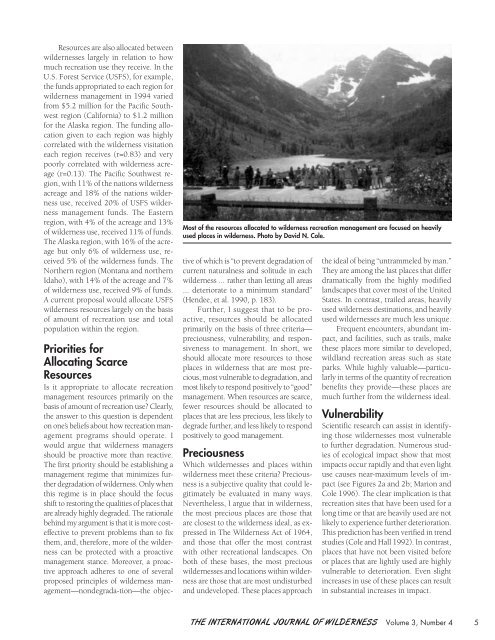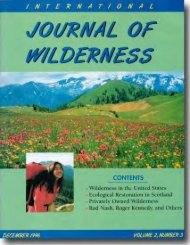Download full PDF - International Journal of Wilderness
Download full PDF - International Journal of Wilderness
Download full PDF - International Journal of Wilderness
You also want an ePaper? Increase the reach of your titles
YUMPU automatically turns print PDFs into web optimized ePapers that Google loves.
Resources are also allocated between<br />
wildernesses largely in relation to how<br />
much recreation use they receive. In the<br />
U.S. Forest Service (USFS), for example,<br />
the funds appropriated to each region for<br />
wilderness management in 1994 varied<br />
from $5.2 million for the Pacific Southwest<br />
region (California) to $1.2 million<br />
for the Alaska region. The funding allocation<br />
given to each region was highly<br />
correlated with the wilderness visitation<br />
each region receives (r=0.83) and very<br />
poorly correlated with wilderness acreage<br />
(r=0.13). The Pacific Southwest region,<br />
with 11% <strong>of</strong> the nations wilderness<br />
acreage and 18% <strong>of</strong> the nations wilderness<br />
use, received 20% <strong>of</strong> USFS wilderness<br />
management funds. The Eastern<br />
region, with 4% <strong>of</strong> the acreage and 13%<br />
<strong>of</strong> wilderness use, received 11% <strong>of</strong> funds.<br />
The Alaska region, with 16% <strong>of</strong> the acreage<br />
but only 6% <strong>of</strong> wilderness use, received<br />
5% <strong>of</strong> the wilderness funds. The<br />
Northern region (Montana and northern<br />
Idaho), with 14% <strong>of</strong> the acreage and 7%<br />
<strong>of</strong> wilderness use, received 9% <strong>of</strong> funds.<br />
A current proposal would allocate USFS<br />
wilderness resources largely on the basis<br />
<strong>of</strong> amount <strong>of</strong> recreation use and total<br />
population within the region.<br />
Priorities for<br />
Allocating Scarce<br />
Resources<br />
Is it appropriate to allocate recreation<br />
management resources primarily on the<br />
basis <strong>of</strong> amount <strong>of</strong> recreation use? Clearly,<br />
the answer to this question is dependent<br />
on one’s beliefs about how recreation management<br />
programs should operate. I<br />
would argue that wilderness managers<br />
should be proactive more than reactive.<br />
The first priority should be establishing a<br />
management regime that minimizes further<br />
degradation <strong>of</strong> wilderness. Only when<br />
this regime is in place should the focus<br />
shift to restoring the qualities <strong>of</strong> places that<br />
are already highly degraded. The rationale<br />
behind my argument is that it is more costeffective<br />
to prevent problems than to fix<br />
them, and, therefore, more <strong>of</strong> the wilderness<br />
can be protected with a proactive<br />
management stance. Moreover, a proactive<br />
approach adheres to one <strong>of</strong> several<br />
proposed principles <strong>of</strong> wilderness management—nondegrada-tion—theobjec-<br />
Most <strong>of</strong> the resources allocated to wilderness recreation management are focused on heavily<br />
used places in wilderness. Photo by David N. Cole.<br />
tive <strong>of</strong> which is “to prevent degradation <strong>of</strong><br />
current naturalness and solitude in each<br />
wilderness ... rather than letting all areas<br />
... deteriorate to a minimum standard”<br />
(Hendee, et al. 1990, p. 183).<br />
Further, I suggest that to be proactive,<br />
resources should be allocated<br />
primarily on the basis <strong>of</strong> three criteria—<br />
preciousness, vulnerability, and responsiveness<br />
to management. In short, we<br />
should allocate more resources to those<br />
places in wilderness that are most precious,<br />
most vulnerable to degradation, and<br />
most likely to respond positively to “good”<br />
management. When resources are scarce,<br />
fewer resources should be allocated to<br />
places that are less precious, less likely to<br />
degrade further, and less likely to respond<br />
positively to good management.<br />
Preciousness<br />
Which wildernesses and places within<br />
wilderness meet these criteria? Preciousness<br />
is a subjective quality that could legitimately<br />
be evaluated in many ways.<br />
Nevertheless, I argue that in wilderness,<br />
the most precious places are those that<br />
are closest to the wilderness ideal, as expressed<br />
in The <strong>Wilderness</strong> Act <strong>of</strong> 1964,<br />
and those that <strong>of</strong>fer the most contrast<br />
with other recreational landscapes. On<br />
both <strong>of</strong> these bases, the most precious<br />
wildernesses and locations within wilderness<br />
are those that are most undisturbed<br />
and undeveloped. These places approach<br />
the ideal <strong>of</strong> being “untrammeled by man.”<br />
They are among the last places that differ<br />
dramatically from the highly modified<br />
landscapes that cover most <strong>of</strong> the United<br />
States. In contrast, trailed areas, heavily<br />
used wilderness destinations, and heavily<br />
used wildernesses are much less unique.<br />
Frequent encounters, abundant impact,<br />
and facilities, such as trails, make<br />
these places more similar to developed,<br />
wildland recreation areas such as state<br />
parks. While highly valuable—particularly<br />
in terms <strong>of</strong> the quantity <strong>of</strong> recreation<br />
benefits they provide—these places are<br />
much further from the wilderness ideal.<br />
Vulnerability<br />
Scientific research can assist in identifying<br />
those wildernesses most vulnerable<br />
to further degradation. Numerous studies<br />
<strong>of</strong> ecological impact show that most<br />
impacts occur rapidly and that even light<br />
use causes near-maximum levels <strong>of</strong> impact<br />
(see Figures 2a and 2b; Marion and<br />
Cole 1996). The clear implication is that<br />
recreation sites that have been used for a<br />
long time or that are heavily used are not<br />
likely to experience further deterioration.<br />
This prediction has been verified in trend<br />
studies (Cole and Hall 1992). In contrast,<br />
places that have not been visited before<br />
or places that are lightly used are highly<br />
vulnerable to deterioration. Even slight<br />
increases in use <strong>of</strong> these places can result<br />
in substantial increases in impact.<br />
THE INTERNATIONAL JOURNAL OF WILDERNESS Volume 3, Number 4 5










